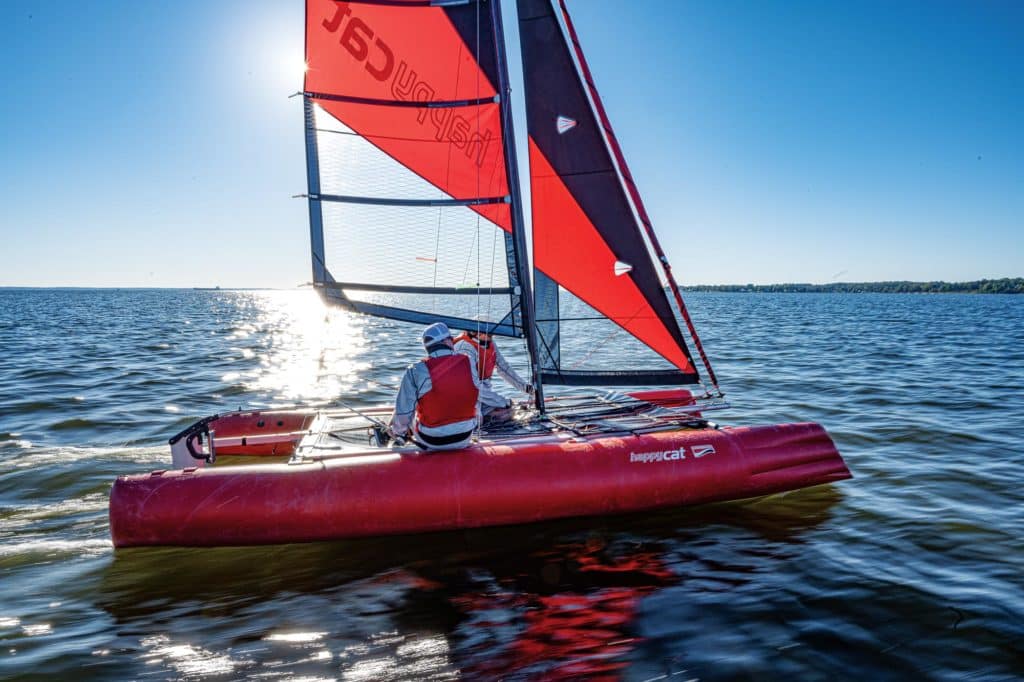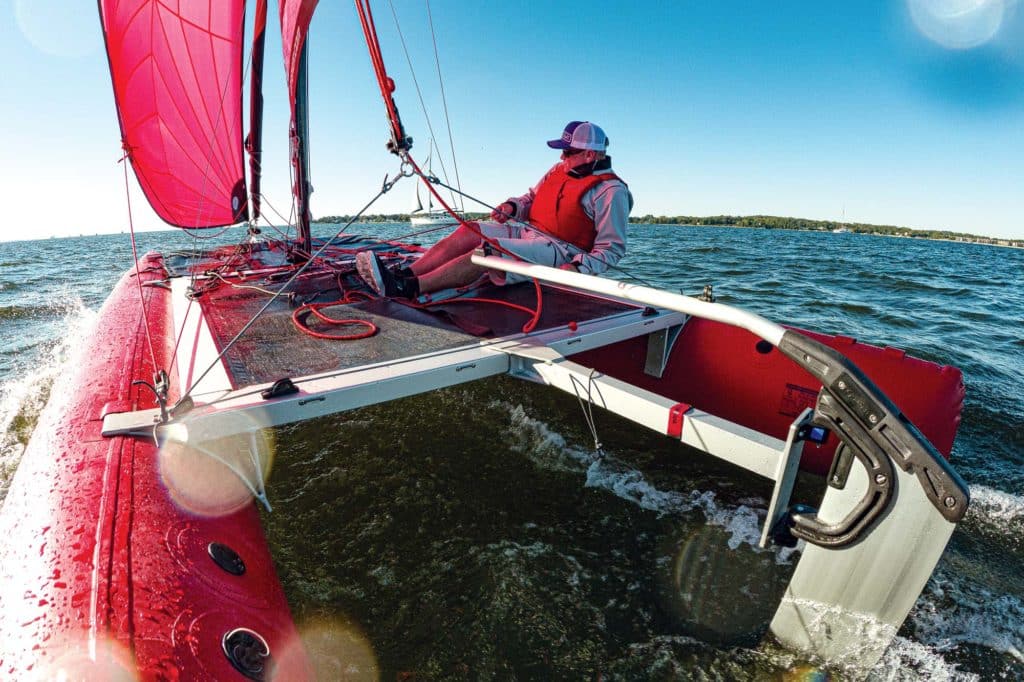Sailing World Magazine’s annual Boat of the Year tests are conducted in Annapolis, Maryland, following the US Sailboat Show. With independent judges exhaustively inspecting the boats on land and putting them through their paces on the water, this year’s fleet of new performance-sailing boats spanned from small dinghies to high-tech bluewater catamarans. Here’s the best of the best from our 2022 Boat of the Year nominees »
Skeptics be warned: The Happy Cat Hurricane is legit. This is the unanimous assessment from our Boat of the Year judging squad after sailing the surprisingly quick and nimble 16-foot inflatable catamaran in 10 knots of breeze. While it delivers exhilarating sailing, it’s much more than a recreational rubber dinghy—it’s an adventure craft, a portable sailboat, a pontoon motorboat, a lazy-river drifter, or anything you want it to be once it’s pumped and splashed.
Grabner is an Austrian manufacturer of all types of inflatable watercraft, which the company has been building since the mid-1980s. The Happy Cat Hurricane came online in 2017, and a carbon-mast version was added in 2019. The Hurricane Carbon, which the judges tested, is the company’s flagship go-fun craft, and apparently, it can’t make them fast enough.
We racers know fiberglass better than we do rubber, but Alex Caslow, of Redbeard Sailing in Baltimore (the US importer), says Grabner’s vulcanized rubber is “tire-quality” and sourced from Continental. All of the Happy Cat’s tubes, he adds, are handmade, glued and welded in Austria, producing high-quality hulls that should last at least 20 years. There’s a seven-year warranty on the hulls, he says, but should you ever need to, $2,000 is your replacement price (per hull). The all-up price for a new boat, with everything you need to go racing or gunkholing, is currently $15,000.
The magic to keeping the Happy Cat’s tubular platform stiff is the anodized aluminum frame that holds it all together. Tension cables crisscrossed beneath the trampolines provide additional stiffness in waves. The frame also serves as attachment points for the trampolines, which are clipped on rather than laced like most catamaran tramps.

The boat, Caslow says, can be assembled in roughly 40 minutes—from taken out of the storage bags to inflated and sails hoisted. Upgrading from the standard manual pump to a 12-volt air pump accelerates the process, of course.
Bags? That’s right. The entire boat and rig fit into four bags collectively small enough to transport in the average-size car trunk. This portability is its primary selling point, especially in Europe, where hundreds of owners and devotees regularly gather to rally and raid on alpine lakes and coastal enclaves. Its second selling point is that it sails as well as most fiberglass recreational catamarans.
“It definitely caught my eye when we first walked up to it,” Chuck Allen says. “The bright-red hulls, the carbon rig, all the ropes, but especially the interesting setup with the rudder and centerboard being on centerline. I’d never sailed a catamaran with a centerboard.
“The hulls are really firm—they feel just like a RIB tube, and all the aluminum framing and wires are nice quality. I was really curious how it would sail, and believe it or not, it sailed like a champ.”

Greg Stewart says his first impression was one of skepticism as well. “It seemed like it would be one of those boats that looked cool on land but would let us down, but it didn’t at all. It sailed amazingly. It tacked well enough that I didn’t have to backwind the jib, and got up to speed again quickly.”
The ability to tack it like a dinghy, Stewart says, is because of the centerboard and because the rudder is mounted in the best place possible. “What makes it steer so well is the rudder is so far aft, which gives you a nice turning moment between it and the centerboard.”
The centerboard has up/down lines that are led to the front beam and cam cleats, but there is a breaker line in case you get into shallow waters. The centerboard casing also acts as an anchor point for the dolphin striker.
The reverse “wave-piercing” bows have a lot of buoyancy down low, Stewart adds. When he was sailing upwind through chop, they “just want to lift and rise up over the wave.” If flying a hull gets a bit too unnerving, he says, a small ease on the mainsheet or a slight bear away makes the boat settle right down with a soft and pillowy landing. Stewart forgot to conduct the obligatory capsize test, but he said afterward that the boat tended to simply slip sideways if the weather hull got too high. The optional masthead float, however, would be a good choice for peace of mind, he says.
“There’s a great sensation of speed,” Powlison reports, especially with the 91-square-foot gennaker. “The Velocitek SpeedPuck that was on the boat was reading 10 to 11 knots regularly, and it wasn’t hard at all to tack or jibe either. The spinnaker clew is pretty high, and the boomless square-top mainsail (124 square feet) makes it really easy to get across the boat.”
“This boat rips,” was Allen’s final assessment. He gave it high marks all around, but what ultimately stole his favor was a browse through Grabner’s catalog, which showcased the Happy Cat’s versatility: Leave the mast in its bag, erect the optional sun awning, and slap on the outboard motor bracket to transform it into an outboard-powered exploration craft and swimming platform. Or strap on extra fore and aft trampolines, load the boat up with camping gear in dry bags, and explore new places.
“Its biggest appeal really is its portability,” Stewart says. “If you don’t have easy access to a yacht club or storage near the water, you can easily keep this in the garage or apartment without taking up much space at all. Throw it in the car and take it wherever you want.”
Assembly, Caslow says, is simple and quick once the hulls are inflated. The tubes slide into grooves in the frame, tension cables are clipped on with carabiners, the trampoline is strapped on, and the mast can be raised by one person once it’s pinned onto the ball joint.
When it’s assembled, the Hurricane Carbon is only 175 pounds, but it is still a bit unwieldy for solo ramp launching. For this particular challenge, Grabner offers flip-up “slip wheels” that mount to the aft beam and stay on the boat while sailing. With your standard big-wheeled catamaran dolly, however, it’s easy to move around and beach-launch. And once you’re underway and zipping along, crew extended on the wire and the soft bounce of the hull on your bottom, you’ll just want to keep on sailing—happy as a cat on nip.









